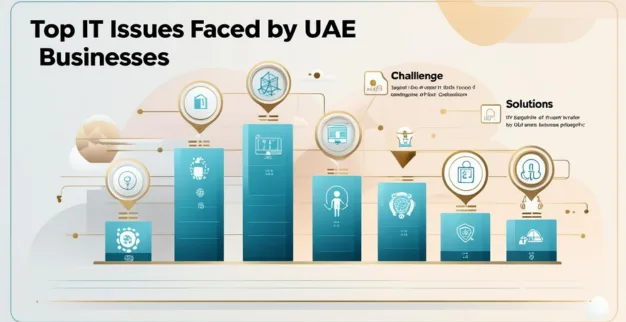Top IT Issues UAE Businesses Face—and the Fix
By: Ganesan D
08 Aug 2025
Category: IT Security
UAE businesses of all sizes are racing into the digital era, but that journey comes with common pain points. From steep cybersecurity threats to ballooning cloud costs and scarce talent, staying competitive demands tackling these IT challenges head‑on.
1. Escalating Cybersecurity Risks
As UAE enterprises digitalise operations, cybersecurity has become a top concern. Reports cite a 400% rise in cyberattacks since 2020, with average Middle East data breach costs reaching AED 27.34 million in 2024. Breaches aren’t just financial—they can trigger regulatory penalties under UAE laws and severely damage trust.
The Solution:
- Adopt Zero Trust architecture—never assume internal networks are safe.
- Use AI‑powered threat detection tools like Cortex XDR or CrowdStrike.
- Enroll staff in regular cyber hygiene training, especially phishing simulations.
- Partner with trusted cybersecurity providers who understand UAE regulation and compliance.
2. Cloud Complexity and Cost Sprawl
The UAE’s “Cloud First” push is driving cloud adoption to over 90% of firms by end of 2025—but with it comes cloud sprawl and runaway costs.
Issues include:
- Fragmented use of AWS, Azure, and Google with no governance.
- Unused services driving subscription costs.
- Hidden vendor lock‑in dangers.
- Unclear security responsibilities between provider and business.
The Solution:
- Conduct regular cloud audits to identify idle resources.
- Implement a multi-cloud governance framework to centralise compliance and billing.
- Use FinOps tools (like CloudHealth) to monitor, optimize, and forecast spending.
- Bring in a cloud consultancy (e.g. Missan IT) to build efficient architecture—and cap costs.
3. IT Talent Shortage & Skills Gaps
Digital growth outpaces skills available in fields like AI, cloud, cybersecurity, and DevOps. Businesses face a serious IT talent crunch—a projected 15,000 unfilled roles by 2025 in the UAE. High expat turnover and visa restrictions compound the problem, especially for SMEs.
The Solution:
- Partner with Managed IT Service providers or outsourcing firms for supplemental skill pools.
- Launch upskilling initiatives using local training programs or educational institutions.
- Offer hybrid work, benefits, or flexible hiring to attract international talent.
- Develop early pipelines via engagement with universities and vocational institutes.
4. Legacy Systems & Integration Hurdles
Many UAE companies still rely on outdated systems that don’t mesh with modern cloud and AI tools, causing bottlenecks and integration headaches. Without careful planning, efforts to transform get stuck in “pilot purgatory” without real ROI.
The Solution:
- Start with an IT audit—identify legacy gaps before adoption.
- Use phased integration: first move non-critical functions to cloud/apps, then more core systems.
- Adopt modular or low-code platforms to bridge old and new systems more flexibly.
- Ensure clear digital roadmaps tie technical change back to business value.
5. Regulatory Compliance & Data Protection
The UAE’s Personal Data Protection Law (PDPL) and cybersecurity laws impose strict compliance requirements. Businesses risk heavy fines if data is mishandled or leaked.
The Solution:
- Work with compliance experts to align your data practices with PDPL standards.
- Build policies around data privacy, access control, consent, and incident response.
- Conduct regular privacy audits and security assessments.
- Train teams on compliance protocols, especially across departments handling customer data.
6. Resistance to Change & Cultural Barriers
Often overlooked—but impactful—is the challenge of cultural resistance. Many organizations struggle to shift traditional mindsets, slowing digital transformation despite the best tools being in place.
The Solution:
- Form cross-functional leadership teams to oversee change.
- Employ change management strategies: frequent communication, quick wins, and feedback loops.
- Launch ongoing internal training and certifications, fostering ownership of digital tools.
- Highlight early successes to build momentum and buy-in.
Why These Fixes Matter Now
With the UAE investing heavily in AI, smart infrastructure, and innovation hubs like Dubai Internet City, businesses must be ready to scale quickly—and securely. Proactive IT strategies also smooth compliance under new frameworks like the 15% minimum top-up tax, Emiratisation rules, and evolving personal data regulations.
Final Takeaway
For UAE businesses, IT isn’t just a support function—it’s the engine of growth. But that engine only works efficiently if cybersecurity is robust, cloud infrastructure is governed, talent is cultivated, legacy systems are tamed—and compliance and culture are aligned. Tackling these issues with strategic planning and trusted partners can turn IT challenges into transformative strengths.



